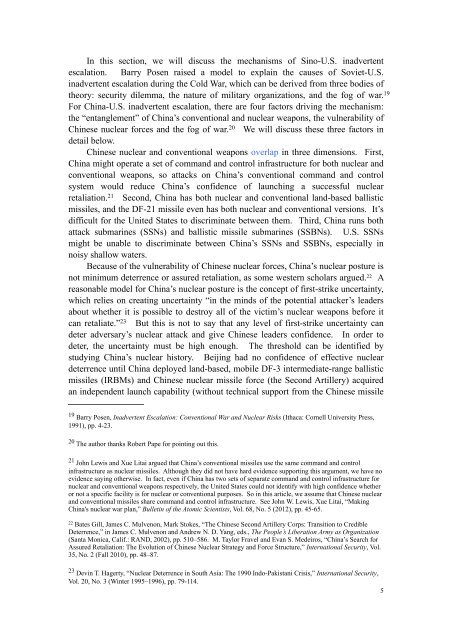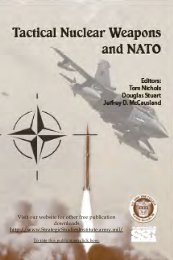Wu Sino US Inadvertent Escalation - Program on Strategic Stability ...
Wu Sino US Inadvertent Escalation - Program on Strategic Stability ...
Wu Sino US Inadvertent Escalation - Program on Strategic Stability ...
You also want an ePaper? Increase the reach of your titles
YUMPU automatically turns print PDFs into web optimized ePapers that Google loves.
In this secti<strong>on</strong>, we will discuss the mechanisms of <str<strong>on</strong>g>Sino</str<strong>on</strong>g>-U.S. inadvertent<br />
escalati<strong>on</strong>. Barry Posen raised a model to explain the causes of Soviet-U.S.<br />
inadvertent escalati<strong>on</strong> during the Cold War, which can be derived from three bodies of<br />
theory: security dilemma, the nature of military organizati<strong>on</strong>s, and the fog of war. 19<br />
For China-U.S. inadvertent escalati<strong>on</strong>, there are four factors driving the mechanism:<br />
the “entanglement” of China’s c<strong>on</strong>venti<strong>on</strong>al and nuclear weap<strong>on</strong>s, the vulnerability of<br />
Chinese nuclear forces and the fog of war.<br />
20<br />
We will discuss these three factors in<br />
detail below.<br />
Chinese nuclear and c<strong>on</strong>venti<strong>on</strong>al weap<strong>on</strong>s overlap in three dimensi<strong>on</strong>s. First,<br />
China might operate a set of command and c<strong>on</strong>trol infrastructure for both nuclear and<br />
c<strong>on</strong>venti<strong>on</strong>al weap<strong>on</strong>s, so attacks <strong>on</strong> China’s c<strong>on</strong>venti<strong>on</strong>al command and c<strong>on</strong>trol<br />
system would reduce China’s c<strong>on</strong>fidence of launching a successful nuclear<br />
retaliati<strong>on</strong>.<br />
21<br />
Sec<strong>on</strong>d, China has both nuclear and c<strong>on</strong>venti<strong>on</strong>al land-based ballistic<br />
missiles, and the DF-21 missile even has both nuclear and c<strong>on</strong>venti<strong>on</strong>al versi<strong>on</strong>s. It’s<br />
difficult for the United States to discriminate between them. Third, China runs both<br />
attack submarines (SSNs) and ballistic missile submarines (SSBNs). U.S. SSNs<br />
might be unable to discriminate between China’s SSNs and SSBNs, especially in<br />
noisy shallow waters.<br />
Because of the vulnerability of Chinese nuclear forces, China’s nuclear posture is<br />
not minimum deterrence or assured retaliati<strong>on</strong>, as some western scholars argued.<br />
22<br />
A<br />
reas<strong>on</strong>able model for China’s nuclear posture is the c<strong>on</strong>cept of first-strike uncertainty,<br />
which relies <strong>on</strong> creating uncertainty “in the minds of the potential attacker’s leaders<br />
about whether it is possible to destroy all of the victim’s nuclear weap<strong>on</strong>s before it<br />
can retaliate.”<br />
23<br />
But this is not to say that any level of first-strike uncertainty can<br />
deter adversary’s nuclear attack and give Chinese leaders c<strong>on</strong>fidence. In order to<br />
deter, the uncertainty must be high enough. The threshold can be identified by<br />
studying China’s nuclear history. Beijing had no c<strong>on</strong>fidence of effective nuclear<br />
deterrence until China deployed land-based, mobile DF-3 intermediate-range ballistic<br />
missiles (IRBMs) and Chinese nuclear missile force (the Sec<strong>on</strong>d Artillery) acquired<br />
an independent launch capability (without technical support from the Chinese missile<br />
! 19 Barry Posen, <str<strong>on</strong>g>Inadvertent</str<strong>on</strong>g> <str<strong>on</strong>g>Escalati<strong>on</strong></str<strong>on</strong>g>: C<strong>on</strong>venti<strong>on</strong>al War and Nuclear Risks (Ithaca: Cornell University Press,<br />
1991), pp. 4-23.<br />
! 20 The author thanks Robert Pape for pointing out this.<br />
! 21 John Lewis and Xue Litai argued that China’s c<strong>on</strong>venti<strong>on</strong>al missiles use the same command and c<strong>on</strong>trol<br />
infrastructure as nuclear missiles. Although they did not have hard evidence supporting this argument, we have no<br />
evidence saying otherwise. In fact, even if China has two sets of separate command and c<strong>on</strong>trol infrastructure for<br />
nuclear and c<strong>on</strong>venti<strong>on</strong>al weap<strong>on</strong>s respectively, the United States could not identify with high c<strong>on</strong>fidence whether<br />
or not a specific facility is for nuclear or c<strong>on</strong>venti<strong>on</strong>al purposes. So in this article, we assume that Chinese nuclear<br />
and c<strong>on</strong>venti<strong>on</strong>al missiles share command and c<strong>on</strong>trol infrastructure. See John W. Lewis, Xue Litai, “Making<br />
China's nuclear war plan,” Bulletin of the Atomic Scientists, Vol. 68, No. 5 (2012), pp. 45-65.<br />
! 22<br />
Bates Gill, James C. Mulven<strong>on</strong>, Mark Stokes, “The Chinese Sec<strong>on</strong>d Artillery Corps: Transiti<strong>on</strong> to Credible<br />
Deterrence,” in James C. Mulven<strong>on</strong> and Andrew N. D. Yang, eds., The People’s Liberati<strong>on</strong> Army as Organizati<strong>on</strong><br />
(Santa M<strong>on</strong>ica, Calif.: RAND, 2002), pp. 510–586. M. Taylor Fravel and Evan S. Medeiros, “China’s Search for<br />
Assured Retaliati<strong>on</strong>: The Evoluti<strong>on</strong> of Chinese Nuclear Strategy and Force Structure,” Internati<strong>on</strong>al Security, Vol.<br />
35, No. 2 (Fall 2010), pp. 48–87.<br />
! Devin T. Hagerty, “Nuclear Deterrence in South Asia: The 1990 Indo-Pakistani Crisis,” Internati<strong>on</strong>al Security,<br />
23<br />
Vol. 20, No. 3 (Winter 1995–1996), pp. 79-114.<br />
! 5








